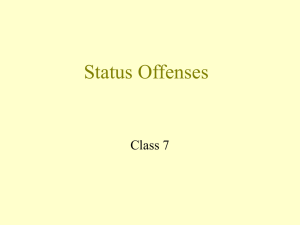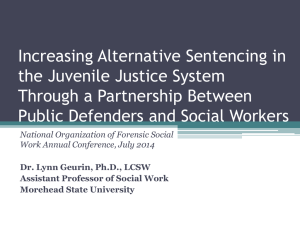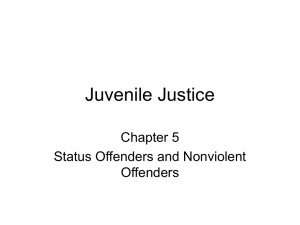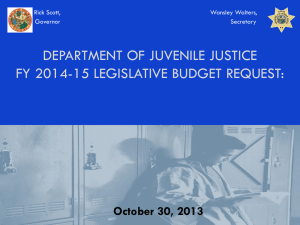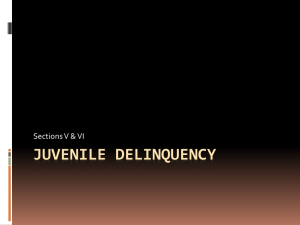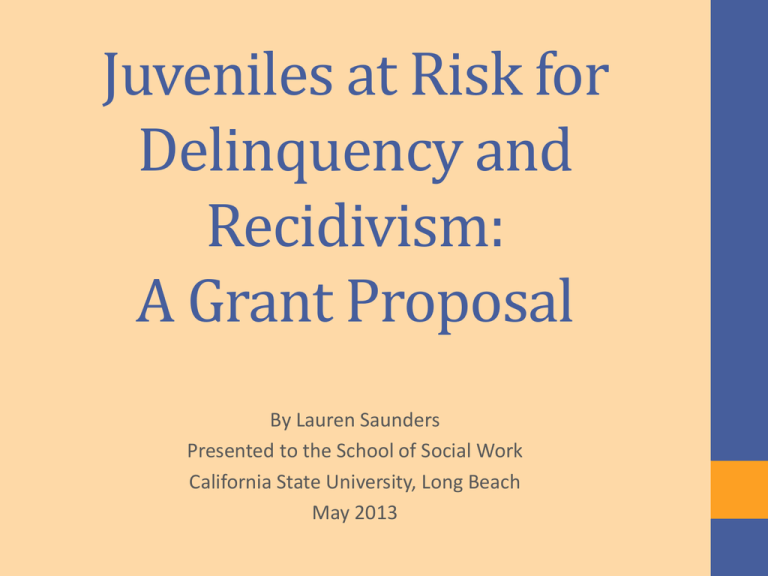
Juveniles at Risk for
Delinquency and
Recidivism:
A Grant Proposal
By Lauren Saunders
Presented to the School of Social Work
California State University, Long Beach
May 2013
Introduction
Juvenile delinquency is an issue that impacts the Long Beach community
• In 2009 juvenile arrests in Los Angeles County (49,182) accounted for 24%
of the total juvenile arrests in the State of California (204,696) (Snyder,
2011).
• That year in Long Beach specifically, there were 874 juvenile felony arrests
(California Department of Justice, Office of the Attorney General, 2012).
• Juvenile misdemeanor arrests in Long Beach in 2009 totaled 2,356
(California Department of Justice, Office of the Attorney General, 2012)
Purpose of the project
• To develop a program that decreases juvenile crime rates in Long Beach,
California.
• The proposed program will target non-violent juvenile offenders ages 14–
17 years of age, residing within the Long Beach Unified School District
• The program will intervene at the individual, familial, and community
levels.
Social Work Relevance
• Social workers are often referred to as “change agents.” Among their
professional duties, social workers strive to eliminate the discrimination
and inequality individuals may experience as the result of their ethnicity,
racial background, age, sex, gender and so on (National Association of
Social Workers, 2008).
• Social workers also approach their practice from a systems perspective,
acknowledging that individuals’ lives are affected by a combination of
biological, psychological, and social factors.
• Applying a social work perspective and approach to juvenile delinquency
prevention is key to ensuring that adolescents receive services that are
free from discrimination and domination.
• Through prevention efforts, social workers can work toward eliminating
social violence and promote individual liberties. Delinquency prevention
is related to social work activities in that it aims to improve the lives of
individuals and groups and looks critically at social norms, seeking to
change them.
Cross-Cultural Relevance
Minority status increases an adolescent’s likelihood of
involvement with the juvenile justice system (Benekos et al.,
2011; Farrington et al., 2010). Minority youth are arrested at
higher rates, and are more likely to be detained in institutions
than Caucasian youth (Deitch et al., 2009). Because of the over
representation of minority youth involved with the juvenile
justice system, this program will employ a diverse staff, who will
be able to respond to the specific needs of adolescents from a
variety of ethnic backgrounds. Cultural competence trainings will
also be provided to program staff. Consultation with community
professionals and agencies working with similar populations will
also be utilized in order to ensure culturally competent
programming.
Methods
Target population
• Non-violent juvenile offenders ages 14–17 years of age, residing
within the Long Beach Unified School District
Identification of funding source
• This grant writer visited the Long Beach Nonprofit Partnership and
utilized its Foundation Directory On-line database
• Subject terms used included:
• “crime/ violence prevention;” “offenders/ ex-offenders, probation/
parole;” “Offenders/ ex-offenders, rehabilitation;” “family services,
counseling;” “human services, mind/ body enrichment;” “human
services, self-help groups;” “youth, services;” “mental health,
counseling/ support group;” “recreation;” and “youth development,
adult & child programs.”
Methods Cont.
Selected funding source
• California Wellness Foundation
• Giving focused on underserved populations, with a specific interest
in youth and families of urban areas, and promoting health and
wellness (California Wellness Foundation, 2012)
Sources used for needs assessment
• U.S. Census Bureau, California State juvenile justice statistics, Los
Angeles County Department of Probation, and LA County
demographic statistics were referenced
• Scholarly, peer reviewed journals, articles and books were also
explored
Projected budget
• $ 95,555
Grant Proposal
Program description
• Ascend aims to decrease juvenile crime rates in Long Beach, California.
• Intervention will take place with individuals, families, and communities.
• Implementation will be in three 12-week cycles a year, serving 10-15
adolescents per cycle.
• Programing will include (a) weekly Functional Family Therapy sessions, (b)
weekly group psychotherapy sessions, (c) rock climbing activities, (d) case
management/ resource referrals and, (e) adult allies.
• Ascend will be hosted by community non-profit, Operation Jump Start.
Population served
• Non-violent juvenile offenders ages 14–17 years of age, residing within the
Long Beach Unified School District (LBUSD).
• Youth who are currently enrolled in a formal probation program and who
are housed in the community (as opposed to a Probation Camp).
• Racial/ ethnic makeup of participants will reflect that of the LBUSD.
Grant Proposal Cont.
Program objectives
• By the end of the 12-week program:
•
50% of the participating families will have attended 12 family therapy sessions as evinced by attendance
logs
• 50% of the participants will have attended 12 support group sessions as evinced by
attendance logs
• 50% of participants will be able to identify 5 risk factors and 5 alternative activities (such as
volunteering or club involvement) as evinced by case notes
• 60% of participants will be involved in one community activity within 12
months of completing the program as evidenced by follow-up surveys
Program evaluation
• Self-report surveys will be given out during the first support group and family
therapy sessions as well as again during the final sessions
• Initial survey: explore participants’ perceptions of school, their communities, and families
• Post survey: reevaluate initial survey questions and evaluate satisfaction with program
• Survey Monkey questionnaire will be sent to participants one year after
program completion to evaluate the longer-term effectiveness of the
program.
Lessons Learned/ Implications for Social Work
Literature Review
• Identified most effective interventions for the target population
• Allowed for a program design that is based on evidence based practices
• Present a compelling problem statement
Program design
• Had to compromise to meet needs of host agency
Implications for social work
• Social Workers strive to improve the quality of life for others at both the
micro and macro-levels. They work with individuals and communities as
well as with policies. Social Workers approach social issues from a systems
perspective, acknowledging that many different factors act together to
contribute to individual and social problems. Social workers utilize
research methods to determine the best interventions for a given
population or issue. Grant writing is another tool social workers must
learn to use to provide services to individuals and communities. Through
grant writing, social workers can secure funding for programs they develop
to meet the unique needs of at risk or underserved populations.
References
• Benekos, P., Merlo, A., & Puzzanchera, C. (2011). Youth, race, and serious crime: Examining trends and critiquing
policy. International Journal Of Police Science & Management, 13(2), 132-148. doi:10.1350/ijps.2011.13.2.231
• California Department of Justice, Office of the Attorney General (2012). Statistics: Juvenile arrests, 2009.
Retrieved from http://ag.ca.gov/cjsc/statisticsdatatabs/ArrestCityJuv.php
• California Wellness Foundation. (2012). Grants program. Retrieved from http://www.ca wellness.org
• Deitch, M., Barstow, A., Lukens, L., & Reyna, R. (2009). From time out to hard time: Young children in the adult
criminal justice system: Special project report. Austin: The University of Texas at Austin, LBJ School of Public
Affairs
• Farrington, D., Jolliffe, D., Hawkins, J., Catalano, R., Hill, K., & Kosterman, R. (2010). Why are boys more likely to
be referred to juvenile court? Gender differences in official and self-reported delinquency. Victims & Offenders,
5(1), 25-44. doi:10.1080/15564880903422963
• Los Angeles County Department of Probation. (2001). Comprehensive multi-agency juvenile justice plan.
Retrieved from http://probation.lacounty.gog/jjcpa/schiffcardenas.pdf
• National Association of Social Workers. (2008). NASW code of ethics: Guide to everyday professional conduct of
social workers. Retrieved from http://www.socialworkers.org/pubs/code/code.asp.
• Snyder, H. (2011). Arrests in the United States 1980-2009. Retrieved from
http://bjs.ojp.usdoj.gov/index.cfm?ty=pbdetail&iid=2203
• U.S. Census Bureau. (2013). American community survey. Retrieved from http://factfinder2.census.gov
• U.S. Department of Commerce. (2012). 2010 census summary: 2010 census of population and housing.
Retrieved from http://www.census.gov





